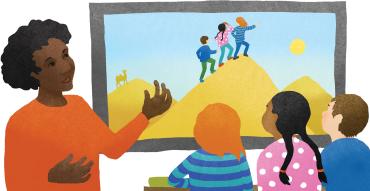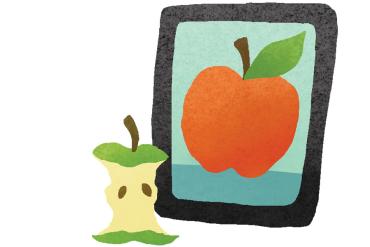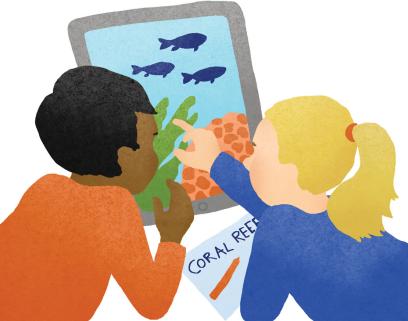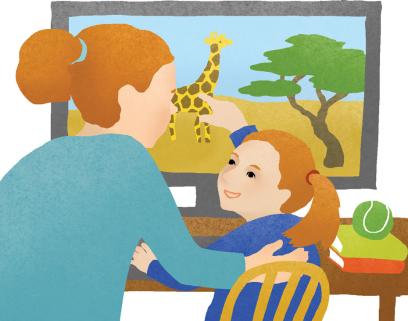“Screen time” has a rotten reputation. Though it is ubiquitous in children’s lives, research suggests it can have a negative impact on child development.1 For example, recent studies show that increased screen use (such as watching television, playing video games, or surfing online) is associated with lower scores on measures of language and literacy in preschool;2 and in elementary school, as access to and use of digital media increases, so do difficulties with academics and behavior.3
Headlines about the negative effects of screen time may alarm teachers and cause them to worry about using digital media with early childhood and elementary school students.4 However, the relationship between digital media use and language and literacy learning is complex, and there are, in fact, arguments both for and against the use of digital media in education.
These benefits and drawbacks are important to understand now more than ever. After the coronavirus pandemic forced almost all schools in the United States to close in the spring, educators quickly pivoted to remote learning. Teachers and families are concerned about children’s screen time—and about how to most effectively create and use digital materials. Although we are all hoping for the virus to abate and for students to learn in school, we also know that, until there is a vaccine, digital media will likely play a significant role in instruction. Because language and literacy development are crucial to all other learning, we focus on helping educators maximize that development using screens.*
Digital media is a broad term describing content that is delivered through technology; it can include text, images, audio, animations, video, and interactives. On the one hand, digital media with abundant sights and sounds may reduce children’s learning by overtaxing their ability to selectively attend to and process important information.5 On the other hand, digital media with more focused and coherent verbal and nonverbal representations of the content may support children’s acquisition and retention of that information.6
For example, consider building relevant knowledge and vocabulary to support comprehension of expository text on a topic such as coral reefs. Sharing an animated video of a fish singing about coral reefs and dancing along to the music may distract children’s attention from the topic and leave children with an unclear understanding of coral reefs. However, using a live-action video of plants and animals in a coral reef swaying gently to the rhythm of the waves accompanied by a clear explanation of what coral reefs are and what kinds of plants and animals live on coral reefs may actually help children learn about this habitat.
In fact, research suggests the effect of digital media on children’s language and literacy learning may depend on a number of factors, including the presentation of the content, the context of the digital media use, and the ages and backgrounds of the children.7 Given the complexity of the research findings, we have distilled several guiding principles to help educators harness the power of screen time to promote (not hinder) language and literacy learning.
Before we dive into these principles, it is important to note that research on using digital media to support language and literacy is still nascent. Much more research across a variety of contexts is needed to understand what works, for whom, and under what conditions. The research we present here provides some initial indications on the types of digital media use that may be helpful in supporting language and literacy, but we encourage researchers to engage in more study of this topic (and policymakers and practitioners to support this research) so that the findings grow more robust and informative.
Digital Media Can Enhance Instruction
While digital media could never replace interaction with a teacher, it can enhance instruction. One way to do this is to identify digital media that can help to reinforce or provide practice with skills or concepts teachers are targeting. For example, in one study with kindergartners from low-socioeconomic backgrounds, instruction focused their attention on the sounds of words in the text.8 Children used e-books that included text to speech, highlighted words, and interactive “hot spots” that could be activated by clicking characters, objects, or words appearing in the text. To ensure distractions were kept to a minimum, hot spots could not be clicked until the narration ended.
Character or object hot spots activated dialogue or sound effects that could enrich story comprehension. Hot spots on words promoted word recognition and phonological awareness† by having the narrator divide the word into syllables. Importantly, the e-books aligned with instruction and did not include irrelevant information that would detract from targeted early literacy skills. Findings showed that children grew in their understanding of concepts about print, word reading, and phonological awareness.
A similar study combined teachers’ instruction and digital media use within a curriculum to promote preschoolers’ vocabulary and conceptual development.9 Teachers used a video from either Sesame Street or Elmo’s World to introduce information about conceptual categories such as healthy foods and wild animals. To help strengthen children’s understanding, researchers chose clips to pair visual information with verbal information. For example, when focusing on insects, a video provided students with a definition and description of the category and showed a katydid, which served as a prototypical example. Teacher-led discussion about the video then followed, as did a read-aloud‡ of an informational book on the same topic. Throughout the insect unit, the discussion focused on features of insects, and the books for the read-alouds reviewed the words and concepts introduced (e.g., antennae). As in the e-book study, the information in the videos aligned with the information in the read-alouds and provided an opportunity for children to learn about the topics across multiple contexts. The result was increased vocabulary and conceptual knowledge.
Web-based digital media programs that align with instruction may also be helpful. In one study, researchers worked with teachers and children in K–2 classrooms across Canada to study the use of a free, web-based digital media program called ABRACADABRA that includes modules focused on aspects of reading (letters and sounds, fluency, comprehension, and writing/spelling).10 Teachers were encouraged to integrate the web-based program with their regular language arts instruction. For example, after children engaged with a digital story on fruit, teachers might ask them to draw and label or write about the fruits they eat. Incorporating multimedia into teachers’ language arts instruction provided children with additional support for their language and literacy skills. In this study—as well as several other studies of the program across the world—children whose teachers used the program performed better on early literacy tasks such as phonological blending and letter-sound recognition.
Other studies have found that closed captioning and highlighted text spoken by a narrator are associated with improving word recognition skills.11 Synchronizing text and speech likely facilitates children’s ability to connect letters with sounds in the words they are learning to read. In addition, videos, e-books, and other digital tools that have rich content with illustrations and animations aligned with dialogue or narration have shown positive effects on vocabulary and comprehension, likely because the illustrations and animations were directly related to the content and therefore supported visual and auditory processing of the information.12
Digital tools can address multiple instructional objectives at once as long as they are included purposefully (not tangentially). For example, carefully crafted e-books for kindergartners and first-graders included segmented speech to support phonological awareness, highlighted text to support word recognition, oral reading to support fluency, visuals of particular words to support vocabulary, and dramatization with action and music intended to facilitate comprehension.13 These books helped children make significant gains in word reading and vocabulary. Note that these features were intentionally chosen to facilitate specific literacy skills. As a counterpoint, consider fairy tale e-books that allow children to click on irrelevant hot spots during story narration (e.g., opening and closing a window on a page when Little Red Riding Hood’s mother is asking her to bring her sick grandmother some treats). By letting children play unrelated games on each page (e.g., “painting” the scene from the story) or, worse, showing them advertisements, such e-books likely detract from children’s learning.
In using specific digital media tools, educators may consider the following guiding questions:
- Does this digital media tool support the skills or concepts I am trying to teach and align with the way I am teaching them?
- Does this tool intentionally present the most important content in complementary visual and verbal ways?
- Is this digital media tool free from distractions that could diminish the learning of skills or concepts I am trying to teach?
Digital Media Can Support Equity and Inclusion
Providing content in multiple ways, and providing a more diverse and representative assortment of content, can be enriching for all students and may be especially so for children from racial, ethnic, and cultural groups that are not appropriately represented in many books and curricula and for children with a range of strengths and needs who have been marginalized all too often.14 For example, digital media that is culturally sustaining may promote the language and literacy of students from underrepresented backgrounds. In one study, a researcher examined the benefits of two programs designed to help children use oracy as a scaffold when reading and writing.15 All students who used the programs showed gains in word recognition, but gains were greater for African American students. The researcher theorized that positive effects for African American students likely resulted from the way the programs drew on African American culture and music to foster reading and writing development.
Research suggests that digital media may support the language and literacy development of children who are learning English as well. A study in which prekindergarten through second-grade children learned about habitats (e.g., ocean, desert, savannah, rainforest) offered content either through read-alouds alone or through read-alouds plus videos.16 The video clips, carefully chosen from National Geographic content, provided real life footage of the habitats in the texts. With the book and video combination, English learners increased their habitat-specific and general vocabulary knowledge, likely because combining visual and verbal information helped children learning English process the new words and content.
In another example, researchers studied the vocabulary and comprehension of English monolingual and Spanish-English bilingual students in upper elementary school who used an online strategic reading intervention that included text-to-speech supports and hypertext definitions, as well as translation from English to Spanish.17 There were positive effects on English vocabulary for all students, and Spanish-English bilingual students developed their English vocabulary at the same rate as their monolingual peers. The authors suggest that multimedia features—such as text to speech, definitions, and translation—were particularly helpful for the bilingual students in the study.
Children with disabilities may also benefit from experiences with carefully selected digital media. A study of scaffolds for K–2 students with intellectual disabilities used e-books and letter- and word-recognition software that were designed to offer appropriate challenge and engagement.18 Scaffolds included videos to build background knowledge, hyperlinks to definitions that included graphics and multimedia illustrations, story enhancements such as being able to click on characters to hear what they are thinking or feeling, models of comprehension strategies and prompts to apply them, and varied response strategies (e.g., multiple choice, sentence starters, and open responses that could be typed or audio recorded). After using the software over the course of an academic year, children outperformed comparable peers who did not use the program in concepts about print, word attack skills, and reading comprehension.
In another study using e-books to support the language and literacy of K–5 children with developmental disabilities,19 children participated in an intervention that included tablet-based multimedia books featuring real-life photographs and videos along with text to support science vocabulary learning. The students learned the taught words and retained their knowledge of them over time. In both studies, using digital media to focus attention, provide scaffolds, and offer concrete and relevant examples and opportunities for practice likely contributed to positive effects.
To help teachers choose the appropriate multimedia to provide a more equitable and inclusive environment for all children, here are a few guiding questions:
- Is the digital media content culturally relevant, responsive, and sustaining for the specific students in my classroom?
- Does the digital media tool offer authentic ways for students to build on their strengths and thereby build bridges to addressing their needs?
- Does the digital media tool include supports for students who are learning English (e.g., definitions, scaffolds for comprehension, and translations) and/or students with disabilities (e.g., appropriately challenging and engaging content with embedded scaffolds to facilitate access)?
Digital Media Can Promote Engagement and Motivation
Digital media can be used to provide opportunities for self-directed learning, to tap into students’ interests, and to promote collaboration among peers, all of which support engagement and motivation. In one study that aimed to increase engagement and motivation while connecting museums and schools, children worked together to use information they collected to design short interactive multimedia presentations with collaborative authoring tools.20 Children engaged in a wide range of learner-driven language and literacy activities (e.g., selecting and evaluating information sources and transforming and communicating knowledge in a variety of formats) and worked with others to prepare and present what they learned. Teachers reported that students’ engagement, motivation, and learning increased.
Using digital media to provide opportunities for collaboration may be especially effective. For example, researchers conducted a study comparing the learning of kindergartners randomly assigned to use e-books in pairs or individually with the learning of children in a control condition.21 While all children who interacted with e-books outperformed control children, children who were in pairs learned more about phonological awareness, emergent reading, and story comprehension than children in the individual learning condition.
In another study, researchers used e-books in a cross-age peer “buddies” learning program.22 Older buddies in fourth grade and younger buddies in kindergarten—many of whom were learning English—interacted with print books, videos, and e-books in an intervention focused on promoting vocabulary and comprehension. The use of different types of media was intended to increase engagement and expose buddies to different types of text related to the same content. In vocabulary, older and younger buddies participating in the intervention outperformed children who did not participate; older buddies also outperformed nonintervention students in comprehension.
Importantly, in both of these e-book studies, children were provided with instruction and support to learn how to use the digital tools together in a collaborative and supportive way.23 Teachers focused on everything from how to use the device and take turns with it to how to pause and discuss the content at critical points. Without such modeling and guidance, children might focus on the bells and whistles of the digital tools instead of using them to more deeply interact with and discuss the content.24 For example, in the cross-age buddies learning mentioned above, when children spent more time clicking hyperlinks and interactives in an e-book, they had less rich conversations about text and spent less time asking and answering questions about the text together. Teacher guidance on how to use such digital tools appropriately can go a long way toward making them effective.
When considering digital media to support engagement and motivation, teachers might consider asking:
- Does this digital media tool promote engagement and motivation in literacy activities without distracting students from what they need to learn?
- Does this digital media tool support student-driven learning in a well-curated context (such as the museum example above) that keeps children engaged in important content as they explore?
- Does this digital media tool foster meaningful collaboration and interaction among peers?
Digital Media Can Leverage Home-School Connections
Access to multimedia in many schools and homes provides an exciting mechanism for student knowledge building and connection between these two spaces. On average, children who are 0 to 5 years old spend about three hours each day on screens; by 8 to 12 years old, screen use is nearly five hours a day (not including school or homework).25 Whether this time is beneficial or detrimental to their language and literacy development depends in large part on the content of the multimedia they access and the amount of parental support they receive while using it.26 Teachers can help ensure this time is infused with learning opportunities by working with families to access educational content aligned with literacy learning goals at home.
There are many ways teachers can help bridge home and school through the use of multimedia. One strategy is to share what children are learning in school via blog posts and videos.27 At home, parents can view these by themselves or with their children and then reinforce the same knowledge and skills, providing children with more opportunities for practice and support. An example of a more formal approach to bridging school and home learning through multimedia and intentional parent engagement is an intervention in which teachers were provided with professional development on using nursery rhymes to support the literacy development of kindergartners from low-income backgrounds. Children in these teachers’ classrooms were provided with videos of the nursery rhymes to later watch with adults at home, and family workshops were held to demonstrate ways of using the videos for educational purposes, such as having children read the text on the screen with an adult. Results from the study showed participating children improved in vocabulary and even outperformed their peers in reading in third grade.
Connecting home and school should not be a one-way street. Bringing home cultures and experiences into school supports children’s engagement in language and literacy learning.28 For example, in one study, teachers worked with third- and fourth-graders to develop digital texts such as blog posts, podcasts, short documentaries, web profiles, digital stories, and online comics that showcased their home and community lives as well as their cultural and linguistic backgrounds.29 Building meaningful connections with students’ homes and communities through the curriculum can help build on children’s prior knowledge, show that they are valued, and tap into their personal interests to leverage engagement in language and literacy instruction.
In searching for digital media tools to promote home-school connections, teachers might consider the following:
- Does this digital media tool promote communication, connection, and collaboration with families?
- Does this digital media tool align with the curriculum such that it strengthens families’ ability to support and extend what students are learning in class?
- Does this digital media tool encourage children and their families to build on and share their knowledge, perspectives, and cultures in ways that are responsive for each child and enriching for the whole class?
Teachers are already critical consumers of media aiming to make careful choices about digital media to support their instruction. As digital media becomes ever more prevalent in schools and at home, and especially as the pandemic makes the need to maximize learning even more urgent, we hope the research reviewed here helps teachers consider the affordances or drawbacks of digital content and tools.
One helpful way of categorizing the features of digital resources contrasts “considerate” (supportive and instructive) versus “inconsiderate” (distracting and obtrusive).30 Considerate features of language and literacy resources include embedded and relevant definitions, pronunciations, translations, comprehension prompts, and text to speech; inconsiderate features include unrelated nontext, distracting hypermedia links, and extraneous hot spots (i.e., pop-ups). Using the guiding questions we provide in this article, teachers may want to determine whether specific digital media tools are considerate and therefore potentially supportive of children’s language and literacy development.§ Ultimately, educators must use their professional judgment—and knowledge of the latest research on digital media—to choose the best resources to support their students’ language and literacy learning.
Rebecca D. Silverman is an associate professor of education at the Stanford Graduate School of Education. A former elementary school teacher, her research focuses on students’ early literacy development. Kristin Keane is a PhD student at the Stanford Graduate School of Education and a former classroom teacher.
* Although remote instruction without the benefit of digital media is outside the scope of this article, we extend our heartfelt thanks to teachers across the country who have dedicated countless hours to creating paper instructional packets and calling students (and their families) who lack adequate internet access or computer equipment at home. We also wish to thank the many advocates working to right the wrong that is the digital divide. (return to article)
† For more on phonological awareness, see “Teaching Reading Is Rocket Science” in the Summer 2020 issue of American Educator, aft.org/ae/summer2020/moats. (return to article)
‡ For more on the power of read-alouds, see “Reading to Learn from the Start” in the Winter 2018–2019 issue of American Educator, aft.org/ae/winter2018-2019/wright. (return to article)
§ To find reviews of specific digital resources, visit commonsense.org/education/search?contentType=reviews. However, keep in mind that technology changes so fast, it is hard for any organization to keep up with the latest multimedia options; unfortunately, researchers can’t mobilize quickly enough to provide high-quality evidence on the effectiveness of most tools on the market. (return to article)
Endnotes
1. “Children and Media: Tips from the American Academy of Pediatrics,” American Academy of Pediatrics, May 2018, bit.ly/32PVego.
2. J. Hutton et al., “Associations Between Screen-Based Media Use and Brain White Matter Integrity in Preschool-Aged Children,” JAMA Pediatrics 174, no. 1 (2019).
3. D. Gentile et al., “Bedroom Media: One Risk Factor for Development,” Developmental Psychology 53, no. 12 (2017): 2340–2355.
4. A. Park, “Too Much Screen Time Can Have Lasting Consequences for Young Children’s Brains,” Time, January 28, 2019.
5. M. Kamil and H. Chou, “Comprehension and Computer Technology: Past Results, Current Knowledge, and Future Promises,” in Handbook of Research on Reading Comprehension, 1st ed., ed. S. Israel and G. Duffy (New York: Routledge, 2009), 289–304; L. Labbo and M. Kuhn, “Weaving Chains of Affect and Cognition: A Young Child’s Understanding of CD-ROM Talking Books,” Journal of Literacy Research 32, no. 2 (2000): 187–210; and J. Sweller, P. Ayres, and S. Kalyuga, Cognitive Load Theory (New York: Springer-Verlag, 2011).
6. R. Mayer, Multimedia Learning, 2nd ed. (New York: Cambridge University Press, 2009); S. Neuman, “Television as a Learning Environment: A Theory of Synergy,” in Handbook of Research on Teaching Literacy Through the Communicative and Visual Arts, ed. J. Flood, S. Brice Heath, and D. Lapp (New York: Taylor and Francis, 2004), 15–22; and A. Paivio, Mental Representations: A Dual Coding Approach (New York: Oxford University Press; Clarendon Press, 1986).
7. M. Bishop and L. Edwards Santoro, “Evaluating Beginning Reading Software for At-Risk Learners,” Psychology in the Schools 43, no. 1 (2006): 57–70; O. Korat and O. Segal-Drori, “E-Book and Printed Book Reading in Different Contexts as Emergent Literacy Facilitator,” Early Education and Development 27, no. 4 (2016): 532–550; and R. Silverman et al., “The Relationship Between Media Type and Vocabulary Learning in a Cross Age Peer-Learning Program for Linguistically Diverse Elementary School Students,” Contemporary Educational Psychology 56 (2019): 106–116.
8. O. Segal-Drori et al., “Reading Electronic and Printed Books with and without Adult Instruction: Effects on Emergent Reading,” Reading and Writing: An Interdisciplinary Journal 23, no. 8 (2010): 913–930.
9. S. Neuman, E. Newman, and J. Dwyer, “Educational Effects of a Vocabulary Intervention on Preschoolers’ Word Knowledge and Conceptual Development: A Cluster-Randomized Trial,” Reading Research Quarterly 46, no. 3 (2011): 249–272.
10. R. Savage et al., “A (Pan-Canadian) Cluster Randomized Control Effectiveness Trial of the ABRACADABRA Web-Based Literacy Program,” Journal of Educational Psychology 105, no. 2 (2013): 310–328.
11. A. Karemaker, N. Pitchford, and C. O’Malley, “Enhanced Recognition of Written Words and Enjoyment of Reading in Struggling Beginner Readers Through Whole-Word Multimedia Software,” Computer and Education 54, no. 1 (2010): 199–208; A. Karemaker, N. Pitchford, and C. O’Malley, “Does Whole-Word Multimedia Software Support Literacy Acquisition?,” Reading and Writing: An Interdisciplinary Journal 23, no. 1 (2010): 31–51; and D. Linebarger and J. Taylor Piotrowski, “Structure and Strategies in Children’s Educational Television: The Roles of Program Type and Learning Strategies in Children’s Learning,” Child Development 81, no. 5 (2010): 1582–1597.
12. D. Altun, “The Efficacy of Multimedia Stories in Preschoolers’ Explicit and Implicit Story Comprehension,” Early Childhood Education Journal 46, no. 1 (2018): 629–642; and D. Smeets and A. Bus, “Interactive Electronic Storybooks for Kindergartners to Promote Vocabulary Growth,” Journal of Experimental Child Psychology 112, no. 1 (2012): 36–55.
13. O. Korat, “Reading Electronic Books as a Support for Vocabulary, Story Comprehension and Word Reading in Kindergarten and First Grade,” Computers & Education 55, no. 1 (2010): 24–31.
14. B. Meyer et al., “Web-Based Tutoring of the Structure Strategy with or without Elaborated Feedback or Choice for Fifth- and Seventh-Grade Readers,” Reading Research Quarterly 45, no. 1 (2010): 62–92.
15. N. Pinkard, “Rappin’ Reader and Say Say Oh Playmate: Using Children’s Childhood Songs as Literacy Scaffolds in Computer-Based Learning Environments,” Journal of Educational Computing Research 25, no. 1 (2001): 17–34.
16. R. Silverman and S. Hines, “The Effects of Multimedia-Enhanced Instruction on the Vocabulary of English-Language Learners and Non-English-Language Learners in Pre-Kindergarten Through Second Grade,” Journal of Educational Psychology 101, no. 2 (2009): 305–314.
17. C. Proctor et al., “Improving Comprehension Online: Effects of Deep Vocabulary Instruction with Bilingual and Monolingual Fifth Graders,” Reading and Writing: An Interdisciplinary Journal 24, no. 5 (2011): 517–544.
18. P. Coyne et al., “Literacy by Design: A Universal Design for Learning Approach for Students with Significant Intellectual Disabilities,” Remedial and Special Education 33, no. 3 (2012): 162–172.
19. C. Rivera et al., “Using a Multicomponent Multimedia Shared Story Intervention with an iPad to Teach Content Picture Vocabulary to Students with Developmental Disabilities,” Education & Treatment of Children 40, no. 3 (2017): 327–352.
20. J. Wishart and P. Triggs, “MuseumScouts: Exploring How Schools, Museums and Interactive Technologies Can Work Together to Support Learning,” Computers & Education 54, no. 3 (2010): 669–678.
21. A. Shamir, O. Korat, and N. Barbi, “The Effects of CD-ROM Storybook Reading on Low SES Kindergartners’ Emergent Literacy as a Function of Learning Context,” Computers & Education 51, no. 1 (2008): 354–367.
22. R. Silverman et al., “Effects of a Cross-Age Peer Learning Program on the Vocabulary and Comprehension of English Learners and Non-English Learners in Elementary School,” Elementary School Journal 117, no. 3 (2017): 485–512.
23. Shamir et al., “The Effects of CD-ROM Storybook Reading”; and Silverman et al., “Effects of a Cross-Age Peer Learning Program.”
24. M. Martin-Beltrán et al., “Using Digital Texts vs. Paper Texts to Read Together: Insights into Engagement and Mediation of Literacy Practices Among Linguistically Diverse Students,” International Journal of Educational Research 82 (2017): 135–146.
25. W. Chen and J. L. Adler, “Assessment of Screen Exposure in Young Children, 1997–2014,” JAMA Pediatrics 173, no. 4 (2019): 391–393; and Common Sense Media, The Common Sense Census: Media Use by Tweens and Teens in 2019 (San Francisco: Common Sense Media, 2019).
26. S. Pappas, “What Do We Really Know About Kids and Screens,” American Psychological Association 51, no. 3 (2020): 42.
27. J. Gillen and N. Kucirkova, “Percolating Spaces: Creative Ways of Using Digital Technologies to Connect Young Children’s School and Home Lives,” British Journal of Educational Technology 49, no. 5 (2018): 834–846.
28. National Academies of Sciences, Engineering, and Medicine, How People Learn II: Learners, Contexts, and Cultures (Washington, DC: National Academy Press, 2018).
29. K. Mills and A. Levido, “iPed: Pedagogy for Digital Text Production,” Reading Teacher 65, no. 1 (2011): 80–91.
30. Labbo and Kuhn, “Weaving Chains of Affect and Cognition.”
[illustrated by Karin Rönmark]





